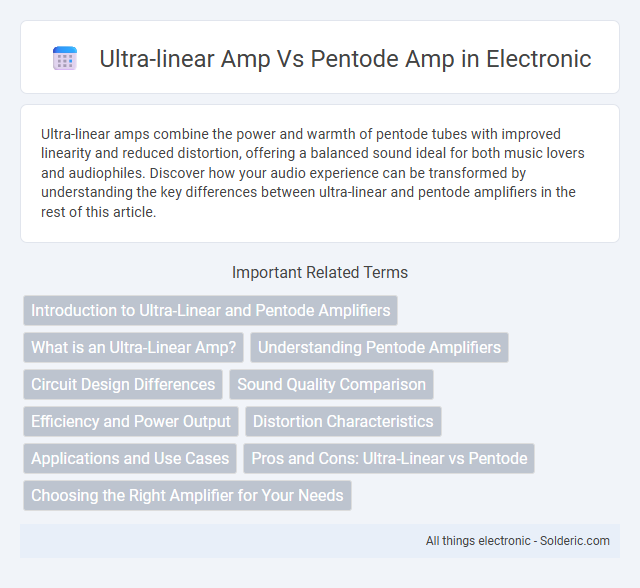Ultra-linear amps combine the power and warmth of pentode tubes with improved linearity and reduced distortion, offering a balanced sound ideal for both music lovers and audiophiles. Discover how your audio experience can be transformed by understanding the key differences between ultra-linear and pentode amplifiers in the rest of this article.
Comparison Table
| Feature | Ultra-linear Amplifier | Pentode Amplifier |
|---|---|---|
| Operation | Partial feedback via screen grid tapped from output transformer | Pentode tube operated without feedback, full pentode mode |
| Sound Quality | Balanced between pentode's power and triode's linearity, lower distortion | Higher power output, more distortion, punchier sound |
| Output Power | Moderate power, optimized for good linearity | Higher maximum output power |
| Distortion | Lower total harmonic distortion | Higher distortion in comparison |
| Efficiency | Moderate; better than triode, less than pentode | High efficiency |
| Typical Use | Hi-fi audio amplifiers requiring balanced sound | Applications requiring high output power and punchy tones |
Introduction to Ultra-Linear and Pentode Amplifiers
Ultra-linear amplifiers operate by tapping the transformer's screen grid connection to achieve a balance between the high power output of pentode operation and the low distortion of triode operation. Pentode amplifiers use vacuum tubes with a separate control grid and screen grid, providing high gain and power but typically with more distortion and lower linearity. Understanding the differences in circuit design and sonic characteristics between ultra-linear and pentode amplifiers is crucial for audio engineers and audiophiles seeking optimal sound quality.
What is an Ultra-Linear Amp?
An Ultra-Linear Amp is a type of tube amplifier that combines characteristics of both triode and pentode operation by tapping the output transformer's screen grid at a specific point, typically around 20-50% of the winding. This configuration results in lower distortion and improved linearity compared to traditional pentode amps, while maintaining higher power output and efficiency than triode amplifiers. You benefit from a balanced sound with warmth and clarity, making Ultra-Linear amps popular in high-fidelity audio systems.
Understanding Pentode Amplifiers
Pentode amplifiers feature a five-electrode vacuum tube design that enhances gain and power output compared to triode amplifiers, making them ideal for high-power audio applications. Their distinctive screen grid reduces the capacitance between the control grid and anode, improving frequency response and stability. Despite higher distortion levels than triode or ultra-linear configurations, pentode amps offer increased efficiency and are valued for their robust, dynamic sound characteristics.
Circuit Design Differences
Ultra-linear amps use a partial feedback arrangement by connecting the screen grid of the pentode tube to a tap on the output transformer, blending characteristics of triode and pentode operation for improved linearity. Pentode amps, on the other hand, connect the screen grid directly to a fixed voltage, maximizing power output but often increasing distortion. Understanding these circuit design differences helps you select the amp topology that best balances power and sound quality for your audio setup.
Sound Quality Comparison
Ultra-linear amps deliver a balanced sound with reduced distortion and enhanced clarity by combining triode and pentode characteristics, resulting in improved midrange detail and smoother high frequencies. Pentode amps produce a more dynamic and powerful output with pronounced bass response but may introduce higher distortion levels and harsher treble. Your choice depends on whether you prioritize clean, articulate sound or a warmer, more robust tonal quality.
Efficiency and Power Output
Ultra-linear amplifiers offer higher efficiency compared to pentode amplifiers by operating output tubes in a mode that blends characteristics of triode and pentode configurations, resulting in lower distortion and improved power output. Pentode amplifiers typically provide greater power output at the cost of reduced efficiency and increased distortion due to their higher gain and separate screen grid voltage. The ultra-linear design achieves a balanced trade-off with power outputs often approaching that of pentode amps while maintaining enhanced efficiency and superior linearity.
Distortion Characteristics
Ultra-linear amps exhibit lower total harmonic distortion (THD) compared to pentode amps, producing cleaner and more accurate sound reproduction. Pentode amps often generate higher distortion levels due to their non-linear operating regions, which can introduce coloration and warmth favored in some music styles. Your choice depends on whether you prefer the precise, low-distortion output of ultra-linear designs or the harmonic richness associated with pentode distortion characteristics.
Applications and Use Cases
Ultra-linear amps dominate high-fidelity audio systems, offering lower distortion and improved linearity ideal for audiophile-grade music playback and studio monitoring. Pentode amps excel in guitar amplification and vintage audio equipment, prized for their higher gain, distinct harmonic saturation, and dynamic tonal coloration. Both amplifier types serve specialized roles, with ultra-linear preferred in precision audio and pentode favored in applications demanding rich harmonic content and expressive sound.
Pros and Cons: Ultra-Linear vs Pentode
Ultra-linear amps offer a balance of low distortion and high power efficiency by tapping the transformer in the screen grid, resulting in smoother, more linear sound reproduction with lower harmonic distortion compared to pentode amps. Pentode amps provide higher gain and greater output power but often introduce more distortion and a harsher tonal character due to their full pentode operation. The trade-off involves ultra-linear designs delivering better sonic clarity and fidelity, while pentode amps emphasize raw power and dynamic punch at the expense of increased noise and coloration.
Choosing the Right Amplifier for Your Needs
Ultra-linear amplifiers offer a balanced sound with lower distortion, making them ideal for audiophiles seeking clarity and precision in music playback. Pentode amps provide higher power output and richer harmonic content, suitable for users who prioritize volume and warmth in sound. Selecting the right amplifier depends on whether you value accurate sound reproduction (ultra-linear) or dynamic, powerful tones (pentode) for your audio setup.
Ultra-linear amp vs Pentode amp Infographic

 solderic.com
solderic.com